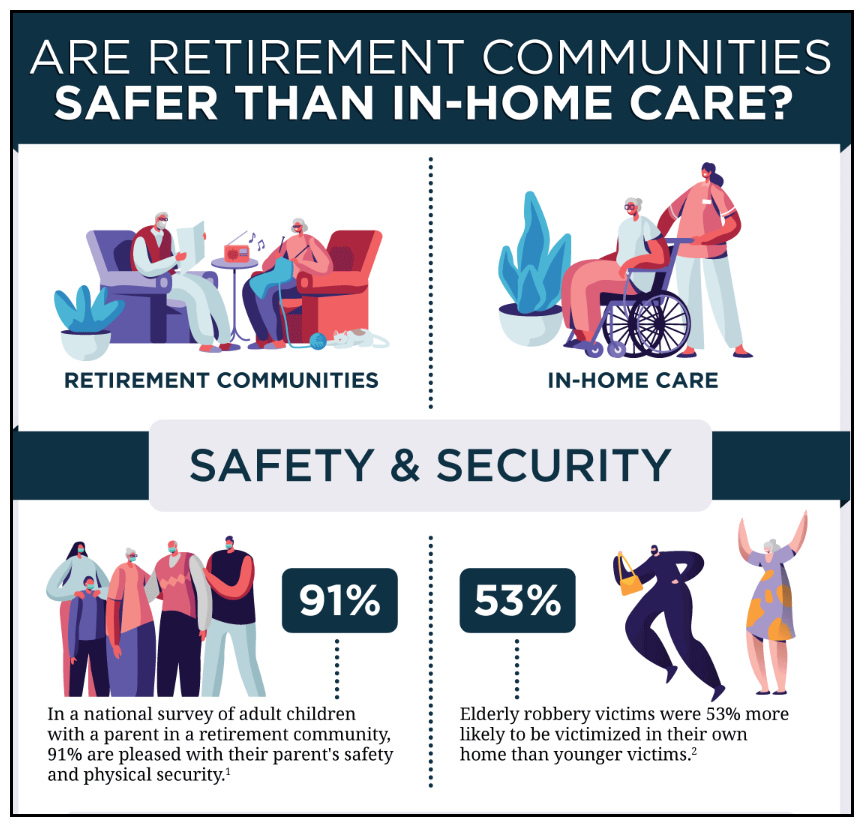ARE RETIREMENT COMMUNITIES SAFER THAN IN-HOME CARE?
 CLICK THE PIC! Just this week I came across a few articles about comparing retirement communities vs. home care. This infographic goes on to compare them in terms of nutrition, safety, connection with others, emergency preparedness, and protection from fire danger, isolation, falling. Here's an intro to the leading article:
CLICK THE PIC! Just this week I came across a few articles about comparing retirement communities vs. home care. This infographic goes on to compare them in terms of nutrition, safety, connection with others, emergency preparedness, and protection from fire danger, isolation, falling. Here's an intro to the leading article:
"When it comes to health and safety concerns, seniors are an especially vulnerable group. Our safety needs and considerations evolve as we get older, which means seniors have to make changes to adapt. For seniors to thrive during retirement, they need to be proactive about their health, safety, and social life.
"Recently, there has been some concern about the safety of retirement communities in light of the global pandemic. To make an informed decision and rise above the public anxiety, it’s important to look at the real data regarding the safety of retirement. View our infographic below for information regarding the safety of retirement communities, as compared to in-home care and living alone.
"More seniors are choosing to live in retirement communities to focus on their health & wellness. From social connection opportunities, convenient meal services and on-site medical staff, senior communities truly place value on the wellbeing of residents. Connect with a Senior Lifestyle community near you to find out more about the health and wellness programs that are just a few clicks away." There's the sales pitch. You now realize that they want you to sign up for a senior community. What's the solution?
Another article in a link from the one above is "The Cost of In-Home Care Versus Senior Community Living" that deals with the very real aspect of expense. Although nearly 90% of seniors want to stay in their homes for as long as they can – it's familiar and full of memories – many seniors with disabilities face architectural barriers: they have heart problems or bad knees, a broken leg or hip that hasn't healed well, a leg amputation, etc., and simply shouldn't stay in their homes.
Senior communities provide better nutrition, safety, connection with others, emergency preparedness, and protection from fire danger, isolation, and falling. But senior communities cost $3,000 to $8,000 per month, the median net worth of retired couples is less than $50,000, and many of them have little or no savings. Their home equity and/or savings would pay for a year or less in a senior community. Then they're broke and out on the street.
Home healthcare isn't cheap either. Very few doctors make housecalls nowadays, and a home health aide can cost over $20 per hour. Insurance might pay less than the full amount for a nurse or an aide to visit, and the number of visits might be limited – after that, you're on your own. A spouse (usually the wife because women live longer) taking care of a disabled spouse often becomes exhausted and simply can't continue caring, so they have to hire someone to provide respite care, or place that spouse in a nursing home... if they can afford it. A child or other relative often must quit their job to provide care for their loved one.
Also, seniors sometimes just can't stay in their homes because they can't climb stairs to bedrooms or go downstairs to do laundry in the basement. Most homes are still not designed to be without stairs inside or outside, all on one floor for seniors. A basic, accessible one-bedroom apartment plus insurance and utilities can easily cost $1,500 per month. That can take up most or all of some people's Social Security income and doesn't provide the level of nutrition, safety, connection with others, emergency preparedness, and protection from fire danger, isolation, and falling that one gets in a senior community. What to do?
This presents an either-or dichotomy, but it doesn't have to be that way. We can combine the advantages of a senior community with the lower costs of home care. Our Agape Restoration Communities concept offers the better nutrition, safety, connection with others, emergency preparedness, and protection from fire danger, isolation, and falling – combined with the lower costs of a one- or two-bedroom living unit all on one floor, with a community room/chapel for connection with other people, common meals, activities like games or exercise, and of course worship together. Home healthcare workers can provide care for more than one person per trip, saving time and transportation expense. It's called "co-living" or "co-housing" where people share living space and common areas, often with a younger person such as a university student having an inexpensive place to live in exchange for a few hours per week of providing care or other services.
This is what Christian community ought to be like: caring for one another and having things in common while at the same time being responsible for oneself as much as possible. So please check out our Agape Restoration Communities!
Go to ARC-News to read our free e-newsletters and Subscribe!

No comments:
Post a Comment